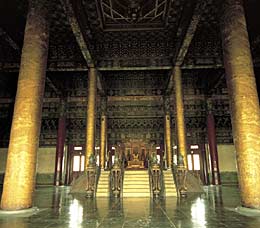The Forbidden City
The Forbidden City (Imperial Palace) in the heart of Beijing is the largest and most complete imperial palace and ancient building complex in China, and the world at large. Its construction began in 1406 and was completed 14 years later, having a history so far of some 580 years. Twenty-four emperors from the Ming and Qing (1644-1911) dynasties lived and ruled China from there. Most of the buildings in the Forbidden City were rebuilt many times, although they maintained the original architectural style.
The Forbidden City, extending 753 meters from east to west, and 961 meters from north to south, makes a rectangular shape and covers a total area of 720,000 square meters. It consists of several dozen compounds of varying sizes and some 9,900 bays of rooms, with a total floor area of 150,000 square meters. Most of the buildings were built with wood, roofed with yellow glazed tiles and built on blue-and-white stone foundations, looking solemn and brilliant. City walls were 10 meters high, and a 52 meter-wide moat surround the Forbidden City. Three-storied towers are placed at each corner of the wall.
The building arrangement within the Forbidden City is symmetrical. The Hall of Supreme Harmony, the Hall of Central Harmony and the Hall of Preserving Harmony, which comprise the outer palace, and the Hall of Heavenly Purity, the Hall of Union and the Hall of Earthly Tranquility, comprising the inner palace, stand in a line from south to north on the central axis. The 8 km central axis runs through the entire old Beijing city to Yongdingmen in the south and Zhonggulou in the north. The throne symbolizing imperial power is positioned at the center of this central axis.
The buildings of the Forbidden City fully embody the artistic features and style of ancient Chinese palace architecture, and can be called a masterpiece in Chinese, even world, architectural history. Today, as the largest museum of cultural relics in China, the Forbidden City, also called the Palace Museum, collected and displayed some one million precious historical relics from the Shang Dynasty (16th century -771 BC) through to the Qing Dynasty. It was made part of the world cultural heritage list in 1987.

Shenyang Imperial Palace
Manchu culture is the centerpiece of the Imperial Palace in Shenyang, capital of northeastern China's Liaoning Province.
Founded in 1624, the 380-year-old Shenyang Imperial Palace is one of the few historic Chinese sites that epitomize an ethnic minority culture, along with the Potala Palace in Lhasa, Tibet.
The main structure of the palace was started by Nuerhachi (1559-1626) and completed by his son Huangtaiji (1592-1643), both founding emperors of the Qing Dynasty. This was China's final dynasty, founded by Manchu aristocrats in 1644 and overthrown in 1911.
As the dynasty expanded its power southward and across the whole China, the Forbidden City in Beijing succeeded Shenyang as royal residence. Even then, Qing Emperors Kangxi and Qianlong, the two longest-ruling emperors in China's history, expanded the palace and added Han and Mongol architectural styles to its original Manchu style.
Shenyang Imperial Palace covers 70,000 square meters and has some 300 rooms in 70 buildings. Though smaller than Beijing's 720,000 square meters Forbidden City, it still has unique features and special historical, artistic and scientific value.
The Dazheng (Grand Politics) Hall, built by Nuerhachi, has a group of 10 Banner Pavilions in the front that were administrative offices for tribal chieftains. The buildings are typically Manchu in style and showcase the "eight-banner system" that originated in the Manchu tribes' hunting process.
Unlike the Forbidden City, which was first built in 1406 and features solely Han culture, the Shenyang palace also highlighted the Manchu people's awe for their ancestors. Huangtaiji, for example, had the Chongzheng (Supreme Politics) Hall built for his enthronement, instead of moving into his father's Dazheng Hall, to show respect.
In July 2004, the UNESCO World Heritage Committee at its 28th session officially inscribed the Shenyang Imperial Palace on the World Heritage List as assemblage of the Imperial Palaces of the Ming and Qing Dynasties.
Management Office of the Forbidden City Tel: 86-10-85117049
Shenyang Imperial Palace Management Office Tel: 86-24-24842215
(China.org.cn January 25, 2005)

